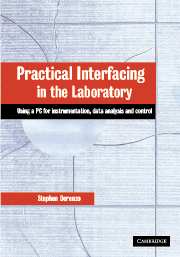Book contents
- Frontmatter
- Contents
- Preface
- Acknowledgments
- 1 Digital tools
- 2 Analog tools
- 3 Analog ↔ digital conversion and sampling
- 4 Sensors and actuators
- 5 Data analysis and control
- Appendix A Grounding and shielding
- Appendix B Experimental uncertainties
- Appendix C C programming tips
- Appendix D Numerical methods and C functions
- Appendix E Summary of Data Translation DT3010 PCI plug-in card
- Appendix F Using the digital oscilloscope to record waveforms
- Appendix G Electrical hazards and safety
- Appendix H Standard resistor and capacitor values
- Appendix I ASCII character set codes
- Glossary
- Index
Appendix A - Grounding and shielding
Published online by Cambridge University Press: 04 August 2010
- Frontmatter
- Contents
- Preface
- Acknowledgments
- 1 Digital tools
- 2 Analog tools
- 3 Analog ↔ digital conversion and sampling
- 4 Sensors and actuators
- 5 Data analysis and control
- Appendix A Grounding and shielding
- Appendix B Experimental uncertainties
- Appendix C C programming tips
- Appendix D Numerical methods and C functions
- Appendix E Summary of Data Translation DT3010 PCI plug-in card
- Appendix F Using the digital oscilloscope to record waveforms
- Appendix G Electrical hazards and safety
- Appendix H Standard resistor and capacitor values
- Appendix I ASCII character set codes
- Glossary
- Index
Summary
Introduction
Noise in electronic circuits includes three basic categories:
noise received with the original signal and indistinguishable from it,
intrinsic noise in the circuit (Johnson, shot, etc.), and
interference noise generated by components in the circuit or picked up from outside the circuit.
This appendix considers only the last category, which is the only form of noise that can be influenced by choices of wiring and shielding. The sections below discuss interference noise from common impedance paths and from capacitive coupling, and list general rules to follow.
Interference noise due to common impedance
Whenever two circuit elements share a common current path, the impedance of that path can couple signals between them. This most commonly occurs when several circuits use a single conductor to return current back to their power supplies. This is shown in Figure A.1, where analog and digital circuits are connected to their power supplies through conductors having impedance Z. The + 5- and ±15-V current supply wires do not share a common impedance and are relatively free from interference noise. On the other hand, the current return path (usually referred to as “ground”) has a common impedance for all circuits and power supplies. A current transient in a digital circuit will briefly shift the “ground” reference for the analog circuits. This problem will generally not be visible using a voltage meter because the effect is brief.
- Type
- Chapter
- Information
- Practical Interfacing in the LaboratoryUsing a PC for Instrumentation, Data Analysis and Control, pp. 504 - 507Publisher: Cambridge University PressPrint publication year: 2003

